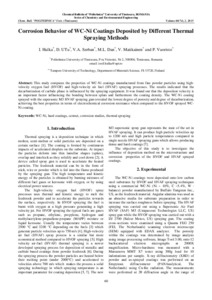Corrosion Behavior of WC-Ni Coatings Deposited by Different Thermal Spraying Methods
Hulka, I.; Utu, D.; Serban, V. A.; Dan, M. L.; Matikainen, V.; Vuoristo, P. (2015)
Hulka, I.
Utu, D.
Serban, V. A.
Dan, M. L.
Matikainen, V.
Vuoristo, P.
2015
This publication is copyrighted. You may download, display and print it for Your own personal use. Commercial use is prohibited
Julkaisun pysyvä osoite on
https://urn.fi/URN:NBN:fi:tty-201612214903
https://urn.fi/URN:NBN:fi:tty-201612214903
Kuvaus
Peer reviewed
Tiivistelmä
This study compares the properties of WC-Ni coatings manufactured from fine powder particles using high-velocity oxygen fuel (HVOF) and high-velocity air fuel (HVAF) spraying processes. The results indicated that the decarburization of carbide phase is influenced by the spraying equipment. It was found out that the deposition velocity is an important factor influencing the bonding between splats and furthermore the coating density. The WC-Ni coating sprayed with the supersonic M3 HVAF spraying gun revealed the lowest degree of porosity and degree of decarburization, achieving the best properties in terms of electrochemical corrosion resistance when compared to the HVOF sprayed WC- Ni coating.
Kokoelmat
- TUNICRIS-julkaisut [16977]
